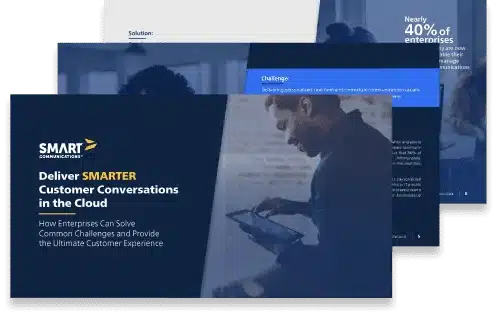London and New York – November 16, 2022 – Smart Communications™, a leading technology company focused on helping businesses engage in more meaningful customer conversations, and OneSpan, the digital agreements security company, today announced the release of its 2022 Future of Customer Experience in Embedded Lending study. Polling 350 senior financial services executives from around the U.S. and UK in July 2022, the MoneyLIVE study explored how the banking industry is responding to embedded lending trends.
Embedded lending – the integration of credit products into non-financial ecosystems – presents a major growth opportunity for lenders and a potential threat. As consumers embrace the simplicity of accessing the funding they need when and where they need it, 45% of loans could be taken out in a non-financial context within just five years. Banking strategies range from developing their own Buy-Now-Pay-Later (BNPL) products to developing partnerships with third parties through Banking as a Service.
“The financial world is reacting to keep up with the shifting customer expectations of fast, easy and convenient digital interactions that are on par with what customers are familiar with and have come to expect in their other online experiences,” said Karen Oakland, VP of Industry Marketing for Financial Services at Smart Communications. “Lenders are hard at work debuting new strategies and offerings to gain wallet share – like embedded lending – and reducing customer effort throughout the lending process is an even bigger priority to drive better customer relationships and success. This research uncovers some of the key considerations and priorities that are shaping the modern financial customer experience today.”
Below is an overview of the study’s key findings:
76% of Execs View Embedded Lending as a Major Priority
Per the research, 76% of respondents said that embedded lending is a major priority for customer experience (CX) and business growth.
But to capitalize on this opportunity, lenders must match the instant gratification expectations of today’s online shoppers who will abandon loan applications and their e-commerce carts if they are faced with unnecessary friction. According to the study, 93% of respondents say that the rise of embedded lending will make smooth and effortless loan applications not just a competitive differentiator but a survival factor.
Embedded lending’s success hinges on frictionless customer experiences
Abandonment rates are a key CX metric and are currently higher for embedded finance lenders than their partners will tolerate. The survey data reveals that the current process requires more effort from the customer due to filling in paper or static forms, repeating information when switching channels, providing proof of ID and other documentation, accessing support from human agents, and signing paper documents.
Customers are having to work too hard to complete loan applications
Per the research results, although 89% of senior executives surveyed say that they have identified filling in paper forms or static web forms as trigger points for high rates of abandonment, 65% of respondents admit that they still rely on static fillable forms as standard practice. This is unfortunate because 75% of those surveyed commonly ask applicants for data the organization already holds internally or could be drawn from third-party sources, thus slowing down the process.
Enabling omnichannel remains a key barrier
The risk of abandonment is highest when applicants are forced to repeat information when switching communication channels. According to the research, 60% of respondents say they expect that the option to switch channels during the application process without having to start again will be viewed as “very important” by potential embedded finance partners. That said, only 9% currently enable customers to start a lending application on one channel and complete it on another without re-entering information. Moreover, 20% don’t enable seamless channel switching at all.
Boosting human assistance emerges as a leading priority
Making sure customers can easily access human assistance across all channels will also be key to keeping the customer journey on track. According to the study, 80% of respondents identified the capability to provide human assistance during a digital loan application without the need to change channel as an important factor in securing embedded finance partnerships. In addition, more than half of the organizations surveyed are investing or planning to invest in behavioral analytics to automatically identify when human assistance is needed, and almost two-thirds are targeting virtual meeting rooms that seamlessly combine digital document completion with a human agent.
E-signature plays a critical role in minimizing abandonment
Companies who offer the option of digital signatures across their lending products say they have reduced the risk of abandonment at signing by half compared to those companies that still require paper-based signing, the survey revealed.
“A digital process that connects data capture, identity validation, document generation and then e-signature results in more completed business,” said Sameer Hajarnis, VP Growth and Transformation at OneSpan. “The research shows that using the latest technology, alongside a secure, seamless experience, will improve customer engagement, reduce risk of customer abandonment, improve operational efficiencies, and increase revenues.” When it comes to securing digital agreements in embedded lending and the broader lending industry, it’s about having assurance throughout the entire customer transaction lifecycle.”
“As banks look for ways to capitalize on this market shift toward embedded lending, it’s more important than ever to adopt a customer-centric approach,” said Oakland at Smart Communications. “Lenders need to make sure they have the ability to support multiple brands, languages and channels, while making sure communications meet regulatory compliance standards around transparency.”
Oakland continues, “Whether for traditional loan products or new embedded finance offerings, the research reveals that lenders need to adopt a customer-centric approach and analyze the trigger points where customer abandonment is happening in the loan process. By making data collection easy through an intuitive, dynamic form that adapts based on customer’s responses, automatically generating the right documentation in the right brand, and integrating e-signature, lenders can improve the customer journey and cut the risk of abandonment in half compared to the legacy process that requires paper-based signing.”
For more information, please read the 2022 Future of Customer Experience in Embedded Lending study.



